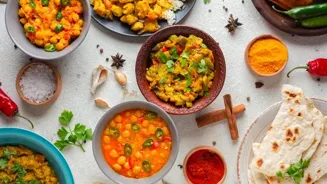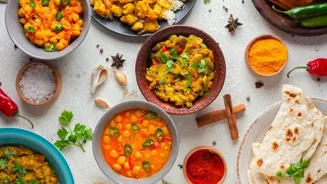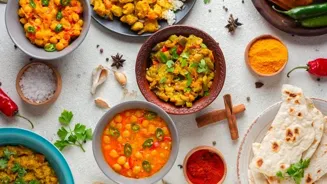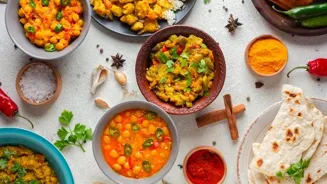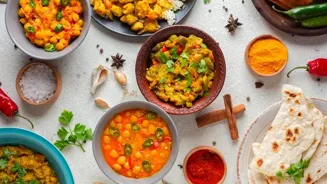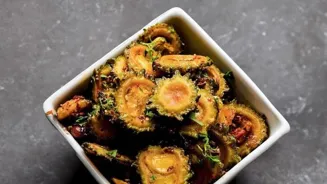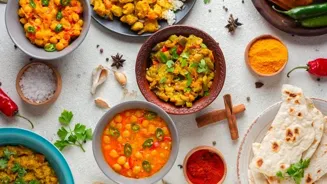Discover the diverse regional cooking styles of India! From Punjab's rich flavors to Bengal's sweets, South India's coconut-infused dishes, Gujarat's sweet, sour, and spicy blends, Rajasthan's hearty meals,
and the Himalayan simplicity, each region offers a unique culinary experience. Embark on this flavorful journey and tantalize your taste buds with the vibrant tastes of India. Read on to explore
Namaste, food lovers! India, a land of diverse cultures and traditions, boasts a culinary landscape as vibrant and varied as its people. From the snow-capped Himalayas to the sun-kissed beaches of the South, each region offers a unique gastronomic experience.
Forget generic “Indian food” – we’re diving deep into the heart of regional cooking styles, unveiling the secrets behind those tantalizing aromas and unforgettable tastes.
Get ready to embark on a delicious journey across the country, discovering the vegetarian culinary gems that make India a food paradise. We promise, your taste buds are in for a treat!
Explore rich, flavorful Punjabi cuisine with hearty dishes and vibrant spices
Let's begin our culinary adventure in the North, specifically Punjab, the land of five rivers. Punjabi cuisine is known for its rich and hearty flavors, often featuring generous use of ghee and cream. While many associate Punjabi food with meaty dishes, the vegetarian options are equally delightful.
Think creamy Dal Makhani, simmered overnight for that melt-in-your-mouth texture, or Chole Bhature, a spicy chickpea curry served with fluffy, deep-fried bread. The tandoor, a clay oven, plays a vital role in Punjabi cooking, imparting a smoky flavor to dishes like Tandoori Roti and Paneer Tikka.
The use of spices like garam masala, ginger, and garlic is also characteristic of this region, adding warmth and depth to the dishes. From the simple yet satisfying Sarson ka Saag and Makki ki Roti to the elaborate vegetarian thalis, Punjabi cuisine offers a feast for the senses.
Don't forget to wash it all down with a tall glass of Lassi, a refreshing yogurt-based drink. It's really a treat for taste buds. You won't be disappointed.
Bengali cuisine: Sweets, spices, and flavors in East India
Moving eastward, we arrive in Bengal, a region famed for its sweets and subtle flavors. Bengali cuisine uses a distinct blend of spices, including panch phoron (a mix of five spices: mustard, fenugreek, cumin, aniseed, and black cumin), and a penchant for mustard oil.

Vegetarian Bengali food is lighter than its northern counterpart. The cuisine emphasizes fresh vegetables, lentils, and fish, often cooked in delicate sauces. Shukto, a mixed vegetable stew with a slightly bitter taste, is a classic Bengali dish known for its health benefits.
Aloo Posto, potatoes cooked in poppy seed paste, is another favorite, simple yet incredibly flavorful. And, of course, no mention of Bengali cuisine is complete without mentioning its incredible desserts.
From the iconic Rasgulla, spongy cheese balls soaked in syrup, to Sandesh, a sweet made from paneer, Bengali sweets are a true indulgence. The use of fresh ingredients and delicate spices makes Bengali food simply irresistible.
Exploring South Indian cuisine: rice, coconut, lentils, spices; vegetarian paradise
Journeying further south, we enter the vibrant world of South Indian cuisine. Here, rice is the staple grain, and dishes are characterized by the use of coconut, lentils, and an array of spices. South India is a vegetarian paradise, with countless options to choose from.
From the crispy Dosas and fluffy Idlis served with Sambar and chutney to the flavorful Uttapams loaded with vegetables, breakfast is a celebration. Sambar, a lentil-based vegetable stew, is a staple in South Indian homes, with each region boasting its unique version.
Rasam, a thin, watery soup with a tangy tamarind base, is another popular dish, often served as a digestive aid. Coconut plays a crucial role in South Indian cuisine, adding richness and flavor to curries and chutneys.
The use of curry leaves, mustard seeds, and asafoetida (hing) is also characteristic of this region, adding a distinctive aroma and taste to the dishes.
From the spicy Chettinad cuisine of Tamil Nadu to the coconut-infused dishes of Kerala, South India offers a diverse and exciting culinary experience.
Exploring vibrant Gujarati cuisine: vegetarian, sweet, sour, spicy dishes
Venturing west, we reach Gujarat, a state known for its predominantly vegetarian cuisine and a subtle sweetness that permeates many dishes. Gujarati food is colorful and flavorful, often featuring a blend of sweet, sour, and spicy tastes.
Dhokla, a steamed lentil cake, is a popular snack, light and flavorful. Theplas, flatbreads made with spices and vegetables, are a staple in Gujarati households, perfect for breakfast or as a travel snack.
Undhiyu, a mixed vegetable casserole cooked underground in earthen pots, is a winter delicacy, showcasing the region's agricultural abundance. Gujarati cuisine also features a variety of dals and kadhis, each with its unique flavor profile.
The use of jaggery (gur) and lemon juice adds a distinctive sweet and sour touch. A typical Gujarati thali is a feast for the senses, offering a variety of dishes, from dals and vegetables to sweets and snacks.
The emphasis on fresh ingredients and balanced flavors makes Gujarati food both healthy and delicious. Plus the sweet touch makes it more unique of the state. It is a must-try cuisine.
Explore Rajasthan's rich cuisine with bold flavors and royal history
Now, let's travel to Rajasthan, the land of kings and majestic forts. Rajasthani cuisine is known for its rich and hearty flavors, designed to withstand the arid desert climate. While meat dishes are popular, vegetarian options are equally satisfying.
Dal Baati Churma, a combination of lentil curry, baked wheat balls, and a sweet crumbled mixture, is the state's signature dish. Gatte ki Sabzi, dumplings made from gram flour cooked in a spicy yogurt-based gravy, is another popular choice.
Rajasthani cuisine also features a variety of vegetables cooked in rich gravies, often using dried fruits and nuts. The use of spices like red chili powder, coriander, and cumin is characteristic of this region, adding warmth and depth to the dishes.
Due to the scarcity of fresh vegetables in the desert, Rajasthani cuisine often utilizes dried lentils, beans, and flour. The food is often cooked in ghee, adding richness and flavor. A Rajasthani thali is a complete meal, offering a variety of dishes, from dals and vegetables to breads and sweets.
Culinary tour of Himalayan region offers simple, satisfying dishes reflecting austere beauty
Our culinary tour ends in the Himalayan region, a land of mountains and monasteries. Himalayan cuisine is influenced by Tibetan and Nepalese flavors, with an emphasis on simple, nourishing dishes. Momos, steamed dumplings filled with vegetables or meat, are a popular snack.
Thukpa, a noodle soup with vegetables and meat, is a warming and comforting dish, perfect for the cold mountain climate. The use of spices is minimal, allowing the natural flavors of the ingredients to shine through.
Himalayan cuisine also features a variety of breads, often made from barley or buckwheat. Butter tea, a salty tea made with yak butter, is a staple drink in this region, providing warmth and energy. The food is simple yet satisfying, reflecting the region's austere beauty.
From the hearty Thukpa to the flavorful Momos, Himalayan cuisine offers a unique culinary experience. It also has the warmth which is needed. Simple to create and a joy to each.
AI Generated Content. Glance/InMobi shall have no liability for the content